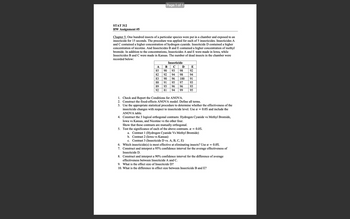
MATLAB: An Introduction with Applications
6th Edition
ISBN: 9781119256830
Author: Amos Gilat
Publisher: John Wiley & Sons Inc
expand_more
expand_more
format_list_bulleted
Question
Just #7-10 please!

Transcribed Image Text:Page 1 of 1
STAT 312
HW Assignment #5
Chapter 5: One hundred insects of a particular species were put in a chamber and exposed to an
insecticide for 15 seconds. The procedure was applied for each of 5 insecticides. Insecticides A
and C contained a higher concentration of hydrogen cyanide. Insecticide D contained a higher
concentration of nicotine. And Insecticides B and E contained a higher concentration of methyl
bromide. In addition to the concentrations, Insecticides A and E were made in Iowa, while
Insecticides B and C were made in Kansas. The number of dead insects in the chamber were
recorded below:
A
Insecticide
B C
D
E
85
90 93 98
92
82
92 94
98
94
83
90 96
100
91
88 91
95
97
93
89 93 96
96
93
92
81 94 99
95
1. Check and Report the Conditions for ANOVA.
2. Construct the fixed-effects ANOVA model. Define all terms.
3. Use the appropriate statistical procedure to determine whether the effectiveness of the
insecticide changes with respect to insecticide level. Use a = 0.05 and include the
ANOVA table.
4. Construct the 3 logical orthogonal contrasts: Hydrogen Cyanide vs Methyl Bromide,
Iowa vs Kansas, and Nicotine vs the other four.
Show that these contrasts are mutually orthogonal.
5. Test the significance of each of the above contrasts. α = 0.05.
a. Contrast 1 (Hydrogen Cyanide Vs Methyl Bromide)
b. Contrast 2 (Iowa vs Kansas)
c. Contrast 3 (Insecticide D vs. A, B, C, E)
6. Which insecticide(s) is most effective at eliminating insects? Use α = 0.05.
7. Construct and interpret a 95% confidence interval for the average effectiveness of
Insecticide D.
8. Construct and interpret a 90% confidence interval for the difference of average
effectiveness between Insecticide A and C.
9. What is the effect size of Insecticide D?
10. What is the difference in effect size between Insecticide B and E?
Expert Solution
This question has been solved!
Explore an expertly crafted, step-by-step solution for a thorough understanding of key concepts.
This is a popular solution
Step 1: Write the given information
VIEW Step 2: Construct and interpret a 95% confidence interval for the average effectiveness of Insecticide D
VIEW Step 3: Construct and interpret a 90% confidence interval for the difference of average effectiveness A & C
VIEW Step 4: Determine the effect size of Insecticide D
VIEW Step 5: Determine the difference in effect size between Insecticide B and E
VIEW Solution
VIEW Trending nowThis is a popular solution!
Step by stepSolved in 6 steps with 16 images

Knowledge Booster
Similar questions
arrow_back_ios
arrow_forward_ios
Recommended textbooks for you
 MATLAB: An Introduction with ApplicationsStatisticsISBN:9781119256830Author:Amos GilatPublisher:John Wiley & Sons Inc
MATLAB: An Introduction with ApplicationsStatisticsISBN:9781119256830Author:Amos GilatPublisher:John Wiley & Sons Inc Probability and Statistics for Engineering and th...StatisticsISBN:9781305251809Author:Jay L. DevorePublisher:Cengage Learning
Probability and Statistics for Engineering and th...StatisticsISBN:9781305251809Author:Jay L. DevorePublisher:Cengage Learning Statistics for The Behavioral Sciences (MindTap C...StatisticsISBN:9781305504912Author:Frederick J Gravetter, Larry B. WallnauPublisher:Cengage Learning
Statistics for The Behavioral Sciences (MindTap C...StatisticsISBN:9781305504912Author:Frederick J Gravetter, Larry B. WallnauPublisher:Cengage Learning Elementary Statistics: Picturing the World (7th E...StatisticsISBN:9780134683416Author:Ron Larson, Betsy FarberPublisher:PEARSON
Elementary Statistics: Picturing the World (7th E...StatisticsISBN:9780134683416Author:Ron Larson, Betsy FarberPublisher:PEARSON The Basic Practice of StatisticsStatisticsISBN:9781319042578Author:David S. Moore, William I. Notz, Michael A. FlignerPublisher:W. H. Freeman
The Basic Practice of StatisticsStatisticsISBN:9781319042578Author:David S. Moore, William I. Notz, Michael A. FlignerPublisher:W. H. Freeman Introduction to the Practice of StatisticsStatisticsISBN:9781319013387Author:David S. Moore, George P. McCabe, Bruce A. CraigPublisher:W. H. Freeman
Introduction to the Practice of StatisticsStatisticsISBN:9781319013387Author:David S. Moore, George P. McCabe, Bruce A. CraigPublisher:W. H. Freeman

MATLAB: An Introduction with Applications
Statistics
ISBN:9781119256830
Author:Amos Gilat
Publisher:John Wiley & Sons Inc

Probability and Statistics for Engineering and th...
Statistics
ISBN:9781305251809
Author:Jay L. Devore
Publisher:Cengage Learning

Statistics for The Behavioral Sciences (MindTap C...
Statistics
ISBN:9781305504912
Author:Frederick J Gravetter, Larry B. Wallnau
Publisher:Cengage Learning

Elementary Statistics: Picturing the World (7th E...
Statistics
ISBN:9780134683416
Author:Ron Larson, Betsy Farber
Publisher:PEARSON

The Basic Practice of Statistics
Statistics
ISBN:9781319042578
Author:David S. Moore, William I. Notz, Michael A. Fligner
Publisher:W. H. Freeman

Introduction to the Practice of Statistics
Statistics
ISBN:9781319013387
Author:David S. Moore, George P. McCabe, Bruce A. Craig
Publisher:W. H. Freeman